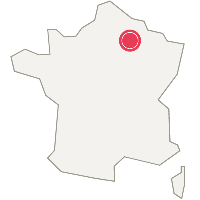You have no items in your shopping cart.
Champagne
Champagne Gosset
(62 customer reviews)
The Gosset champagne house is the oldest in the region. Established in Aÿ for over four centuries, the family has passed on its passion from generation to generation. Its brand image is one of excellence for all lovers of great champagnes. Find out more
 Recommended by
Recommended byParker Wine Advocate - Le Guide Hachette - Decanter
-

Shipped in
secured packaging -

Garantie anti-casse :
Prise en charge totale
The winemaker
Champagne is a Gosset family tradition
The Gosset family's first ancestor was Jean (1484-1556), "Seigneur d'Aÿ et de Mareuil", so over four centuries ago. Since then, sixteen generations of direct lineage have distinguished themselves in Aÿ en Champagne. They were mayors, échevins (i.e. municipal magistrates in the Middle Ages), procurators, but above all winemakers. For the Gossets, growing vines and trading Champagne wines were part of the family.
The winemaking begins with Pierre Gosset. He was an alderman in Aÿ, but above all a winemaker. He is therefore at the origin of the know-how he will pass on to his descendants. Pierre still produces wine, mostly red, from his own Pinot Noir and Chardonnay vines.
In 1610, Claude Gosset created the barrel mark used to mark fûts. In 1738, Simon Gosset was at the head of the company and understood the growing interest in wines from the Champagne region becoming effervescent, and he began making them. In 1760, Jean Gosset was the first to use the famous "Flacon Antique", which became the house's trademark. It is still used today. The champagne house suffered from the phylloxera crisis that ravaged France's vineyards at the end of the 19th century. It fell to André, then his wife, to build up the vineyard.
1960 marked another turning point for the Gosset Champagne house. Suzanne, who was at the helm at the time, was fascinated by innovation and decided to present her champagne rosé in transparent bottles, to highlight its seductive color. In 1993, Gosset was acquired by the Renaud-Cointreau family, already owners of Frapin Cognac in Ségonzac, in the heart of Grande Champagne. The origins of Renaud-Cointreau go back even further, to 1270.
The Gosset style, wines without malolactic fermentation
The Gosset champagne house works its wines without going through malolactic fermentation, in order to preserve intact the malic acid that restores the natural fruity aroma of the wines. This process, along with the entire chain of know-how inherited for so long, makes it possible to produce wines of perfect regularity and rare temperament.
The wines are made from blends that bring together the best crus of the Marne (Grands Crus and Premiers Crus), with an average classification of 95% on the official crus scale.
Gosset champagne production
Champagne Gosset uses pinot noir as its main grape variety, which it supplements with chardonnay and pinot meunier.The vines grow on the chalky soils of the terroir, which extends over 120 hectares, between Reims and the famous Montagne de Reims, the Marne Valley and the Côte des Blancs, south of Épernay.
The grapes are always harvested by hand, after traditional cultivation. Every effort is made to respect the terroir and promote sustainable development. Each year, Gosset produces around 1 million bottles.
Gosset champagnes
Gosset champagnes are wines of the highest quality, they are powerful and vinous, thanks to long ageing on point. The wines are essentially made from pinot noir grapes.
Gosset - Grande Réserve Brut
Grande Réserve is a demonstration of mastery and house style. Thanks to a subtle, racy backbone, it evolves on generous, gourmet notes. With traditional vinification and aging on lees to avoid premature oxidation, and always avoiding malolactic fermentation, the wine's naturally fruity aroma is amply enhanced.La Grande Réserve Brut is 45% Chardonnay and Pinot Noir, with a further 10% Pinot Meunier. It comes from vines in Aÿ, Bouzy, Ambonnay, Le Mesnil-sur-Oger and Villers-Marmery. Each cuvée is aged a minimum of three years in the cellar, at constant temperature, far longer than the legal minimum of fifteen months. Its eye is luminous, with a magnificent golden color. The nose is strongly marked by freshness, with fruit dominating. As usual, Chardonnay brings a subtle delicacy, with dominants that evoke yellow fruit, such as mirabelle plum and peach.
The mouth of Grande Réserve Brut is generous and structured, thanks to the pinot noir d'Aÿ. There's also the white flowers and hawthorn that blend naturally, contrasting with the acidity brought by citrus. Grande Réserve Brut should be served between 8 and 10°C. Aside from the aperitif, during which it always delights guests, it finds its place with free-range poultry, as well as langoustines, oysters, and even tapas. On the cheese side, it's with Comté that it shows the most affinity.
Gosset - Grand Rosé Brut
Grand Rosé Brut also benefits from vinification and ageing on lees to avoid premature oxidation. The wine keeps wonderfully with all its aroma, exceptionally fruity thanks to the absence of malolactic fermentation. The red wines of Ambonnay and Bouzy produce a delicately rosé wine with a fruity taste. The balance is perfect and forms a wine of character, very pure. The house gives it three years of cellar aging to give it the opportunity to express its vinosity.Grand Rosé Brut is composed of 50% chardonnay and 50% pinot noir, including 8% red wine.The grapes come from vineyards in Avize, Chouilly, Villers-Marmery, Bouzy, Ambonnay and Verzenay. Grand Rosé Brut has a soft, fluid eye. Its robe is the color of salmon rose petals, embellished with a few cherry and ruby highlights. Its nose is assertive with smells of fresh strawberries, but also jammy.
With its structured palate, the pulpiness of the red fruit dominates. It's round and still fresh on the finish. Grand Rosé Brut, served between 8 and 10°C, goes well with foie gras, wild salmon and fish or poultry tapas. Then choose a strawberry, raspberry or blueberry dessert.

5 wines available
between 32.1 € and 288.35 €
between 32.1 € and 288.35 €

186 wine's scans
on Twil application
on Twil application

Best rated wines on Twil :
You might like Voir tous les vins de la région
- -32%
- -26%
- -18%
- -22%






















 TWIL - Achat de Vin
TWIL - Achat de Vin


